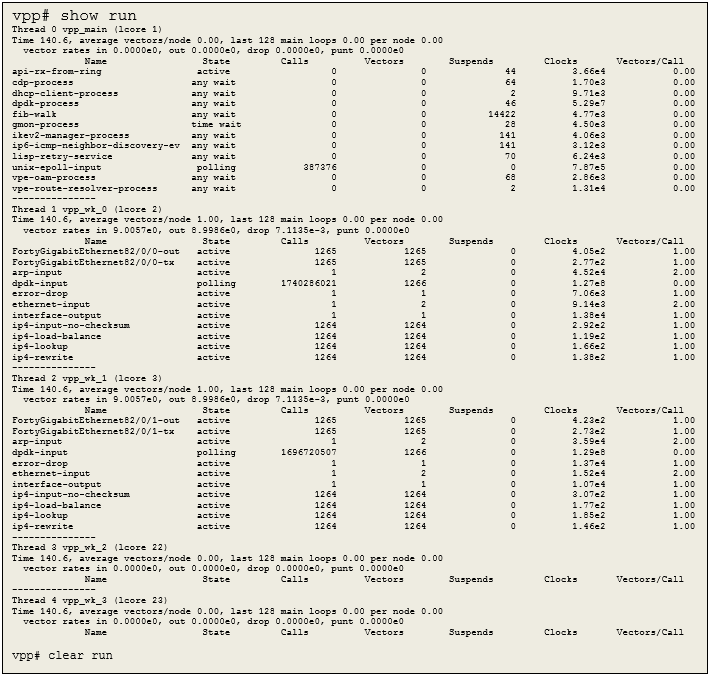Using VPP with TRex
In this example we use only two systems, csp2s22c03 and net2s22c05, to run TRex VPP is installed on csp2s22c03 and run as a packet forwarding engine. On net2s22c05, TRex is used to generate both client and server-side traffic. TRex is a high-performance traffic generator. It leverages DPDK and run in user space. Figure 2 illustrates this configuration.
VPP is set up on csp2s22c03 exactly as it was in the previous example. Only the setup on net2s22c05 is modified slightly to run TRex preconfigured traffic files.

Figure 2: The TRex traffic generator sends packages to the host that has VPP running.
First we install TRex.
NET2S22C05$ wget --no-cache http://trex-tgn.cisco.com/trex/release/latest
NET2S22C05$ tar -xzvf latest
NET2S22C05$ cd v2.37
Then show the devices we have.
NET2S22C05$ sudo ./dpdk_nic_bind.py -s
Network devices using DPDK-compatible driver
============================================
0000:87:00.0 'Ethernet Controller XL710 for 40GbE QSFP+' drv=vfio-pci unused=i40e
0000:87:00.1 'Ethernet Controller XL710 for 40GbE QSFP+' drv=vfio-pci unused=i40e
Network devices using kernel driver
===================================
0000:03:00.0 'Ethernet Controller 10-Gigabit X540-AT2' if=enp3s0f0 drv=ixgbe unused=vfio-pci *Active*
0000:03:00.1 'Ethernet Controller 10-Gigabit X540-AT2' if=enp3s0f1 drv=ixgbe unused=vfio-pci
0000:81:00.0 '82599 10 Gigabit TN Network Connection' if=ens787f0 drv=ixgbe unused=vfio-pci
0000:81:00.1 '82599 10 Gigabit TN Network Connection' if=ens787f1 drv=ixgbe unused=vfio-pci
Other network devices
=====================
<none>
Create the /etc/trex_cfg.yaml configuration file. In this configuration file, the port should match the interfaces available in the target system, which is net2s22c05 in our example. The IP addresses correspond to Figure 2. For more information on the configuration file, please refer to the TRex Manual.
NET2S22C05$ cat /etc/trex_cfg.yaml
- port_limit: 2
version: 2
interfaces: ['87:00.0', '87:00.1']
port_bandwidth_gb: 40
port_info:
- ip: 10.10.2.2
default_gw: 10.10.2.1
- ip: 10.10.1.2
default_gw: 10.10.1.1
Stop the previous VPP session and start it again in order to add a route for new IP addresses 16.0.0.0/8 and 48.0.0.0/8, according to Figure 2. Those IP addresses are needed because TRex generates packets that use these addresses. Refer to the TRex Manual for details on these traffic templates.
csp2s22c03$ sudo service vpp stop
csp2s22c03$ sudo service vpp start
csp2s22c03$ sudo vppctl
_______ _ _ _____ ___
__/ __/ _ \ (_)__ | | / / _ \/ _ \
_/ _// // / / / _ \ | |/ / ___/ ___/
/_/ /____(_)_/\___/ |___/_/ /_/
vpp# sho int
Name Idx State Counter Count
FortyGigabitEthernet82/0/0 1 down
FortyGigabitEthernet82/0/1 2 down
local0 0 down
vpp#
vpp# set interface ip address FortyGigabitEthernet82/0/0 10.10.1.1/24
vpp# set interface ip address FortyGigabitEthernet82/0/1 10.10.2.1/24
vpp# set interface state FortyGigabitEthernet82/0/0 up
vpp# set interface state FortyGigabitEthernet82/0/1 up
vpp# ip route add 16.0.0.0/8 via 10.10.1.2
vpp# ip route add 48.0.0.0/8 via 10.10.2.2
vpp# clear run
Now, you can generate a simple traffic flow from net2s22c05 using the traffic configuration file “cap2/dns.yaml”.
NET2S22C05$ sudo ./t-rex-64 -f cap2/dns.yaml -d 1 -l 1000
summary stats
--------------
Total-pkt-drop : 0 pkts
Total-tx-bytes : 166886 bytes
Total-tx-sw-bytes : 166716 bytes
Total-rx-bytes : 166886 byte
Total-tx-pkt : 2528 pkts
Total-rx-pkt : 2528 pkts
Total-sw-tx-pkt : 2526 pkts
Total-sw-err : 0 pkts
Total ARP sent : 4 pkts
Total ARP received : 2 pkts
maximum-latency : 35 usec
average-latency : 8 usec
latency-any-error : OK
On csp2s22c03, the show run command displays the graph runtime statistics.
